Arthropathy of the hip joint is a disease, also known as Coksarrosis, which occurs in a person due to the reduced amount of synovial fluid emitted in the joint cavity.The result is a violation of the nutrition of the cartilage and the gradual damage to the joint surface.The disease is inherent in the course of chronic diseases and is characterized by inflammation but by degenerate changes in cartilage tissue and gradual deformation of bone tissue.
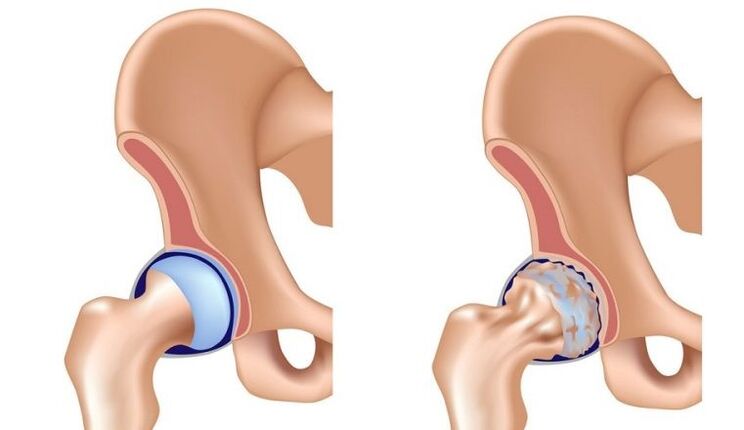
The treatment of COKSARTROSIS is a long and difficult process, and the solution is that established scholars choose the right treatment plan.Due to improper treatment, deep deformation may occur with the depletion of joint structures, and the disease is developing rapidly, which may lead to a complete loss of motor activities in the disabled and affected joints.
symptom
Timely detection of the disease is an important part of further successful treatment.But in the early stages of the disease, there are few symptoms, limited to local pain, with no obvious signs and external changes (lack of edema, color changes and structure).Therefore, in most cases, a person simply does not pay attention to the manifestation of these marks, delaying visits to the doctor, thereby allowing the disease to progress slowly and correctly.
There are four levels of arthritis, and at each stage there are certain symptoms inherent in 1, 2, 3 or 4 stages, but there are certain series of symptoms when it is detected that the doctor should be consulted immediately to detect symptoms of the real disease.Such symptoms include:
- Thigh pain, groin.The pain is real and subsides after a brief break.
- The joints are stiff in the morning.A unique feature of joint disease is mainly in the morning after a long vacation.It is characterized by limiting the mobility, stiffness, and unpleasant feelings of the limb.Usually, about an hour after waking up to disappear the symptoms.
- The tightening in the joints makes a thoughtful sound when walking.
- Changes in gait, appearance of la row.
- The appearance of poor length of limbs.This symptom is found later in the disease, and the shortening or extension of the affected limb is associated with changes in the pelvic structure (its deformation).
The above symptoms are common and found in many other diseases, which is why it is necessary to consult a good expert and adopt other research methods to make the correct differential diagnosis and accurate diagnosis from other similar diseases.
reason
As we age, the body wears, the work of all systems and organs gradually slows down, and metabolism slows down.This applies to the state of bones, joint pockets and cartilage, which under the influence of constant loads thin and deform over time.Losing the amount of synovial fluid filling the joint cavity can lead to reduced natural depreciation and increase load, which can then damage the joint cartilage.
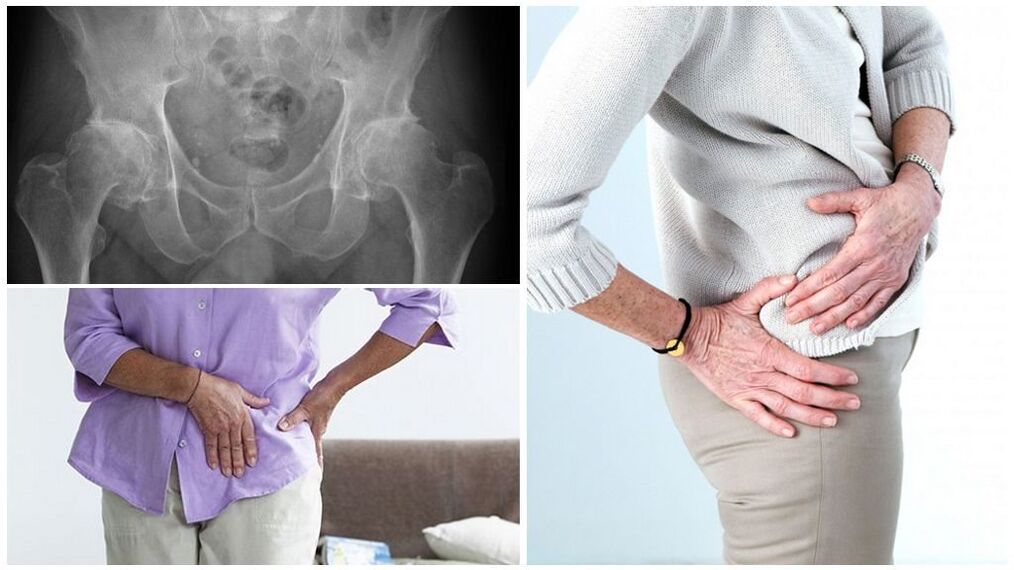
In addition to physiology, related to physical changes related to natural age, other causes of hip arthritis include:
- Heavy physical labor.
- Genetic (it belongs to hip dysplasia).
- Too much weight.Excessive weight increases the load on the musculoskeletal system.
- Hormonal diseases.
- Inflammatory diseases (infectious arthritis, rheumatoid arthritis).
- Post-traumatic arthritis of hip joints occurs 20–40% after injury.
Type and degree of disease
According to clinical results and radiological indicators, 4-degree disease was distinguished.
First degree
If the disease is detected at this stage, treatment is most effective, the affected joints can be preserved by ensuring the correct treatment regimen without surgery.But identifying the disease at this stage is not that simple, because the symptoms shown are not important in themselves and are characterized by this:
- Stiff in the morning.
- Groin pain.
- Secondary pain, pain occurs during physical fatigue in the hip joint.
- On radiographic, in the presence of 1 degree disease, the joint space is slightly reduced, sealing the single focus of the clear cartilage, and bone growth in the rotating area is possible.
Second degree
The second degree of the disease is manifested by more obvious symptoms.The characteristics of this stage are:
- Not only after physical fatigue, but also when performing smaller motor activities, pain in pulling and joint pain will also occur.The pain worsens at night and at night.
- When performing sports activities, the gait changes.There is a "duck walk" where a person attempts to rely on healthy legs after a long walk to protect his legs affected by the sore joints.
- The movement of the affected hip joint is violated, which makes it difficult to leave the affected limb.
- X-rays mark significant stenosis of joint space and bone growth.
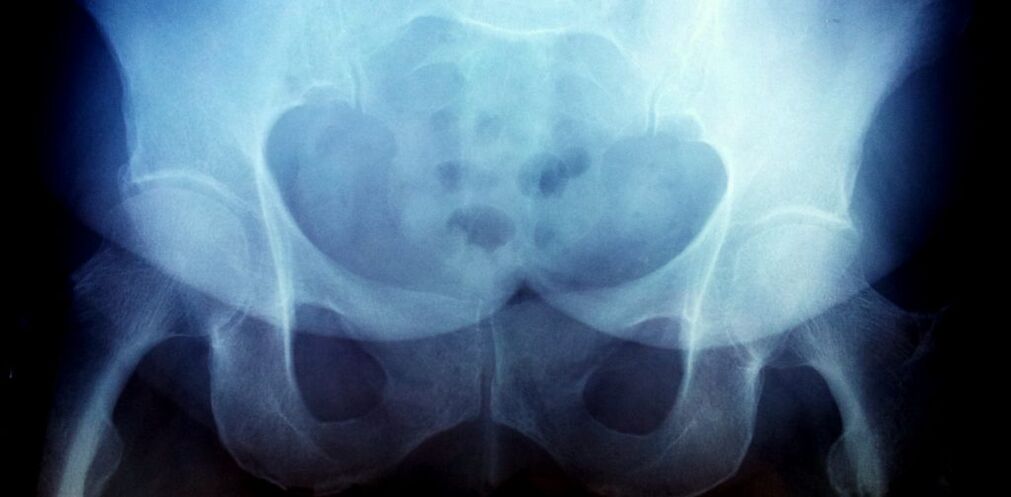
The third degree
The clinical chart shows that:
- Continuous severe pain during load and rest.
- All losses of motor activities in the affected joints.
- The appearance of poor length of limbs.The legs of the affected joints are shorter than those of healthy limbs.
- X-rays mark the complete destruction of the clear cartilage, the growth of the genus Male, and the destruction of the femur.
Fourth degree
The fourth degree of pelvic arthritis is characterized by a complete atrophy of the muscles around the hip joints of the affected limb.In 4 stages, a complete loss of body function was also noted.Patients cannot step on their legs and cannot do without crutches.On X-rays, bones have bone sclerosis, large bone growth and no joint gap at all.
This stage can only be processed through operation.
diagnosis
Many certain studies are required to make accurate diagnosis and prompt treatment.The diagnosis is performed at several stages.
- General examination, dissolution of the disease is collected.Doctors will clarify information about injuries, related illnesses and existing lifestyles.Proper examinations help to correctly diagnose, determine the extent of the disease and eliminate many diseases with similar symptoms, such as arthritis, s bone.
- In addition to the examination, the attending physician also stipulates necessary laboratory examinations.
- X-ray examination is a mandatory diagnostic point.Even though the patient’s complaint applies only to one limb, the hip joints of both legs were studied.
- Computed tomography is considered another research method.Using CT, you can study the nature and extent of damage on the femur and joint surfaces.
Joint therapy
When suspicious symptoms and pain of the hip joint occur, what doctors do to treat this condition and self-assessment problems a person mainly experiences.
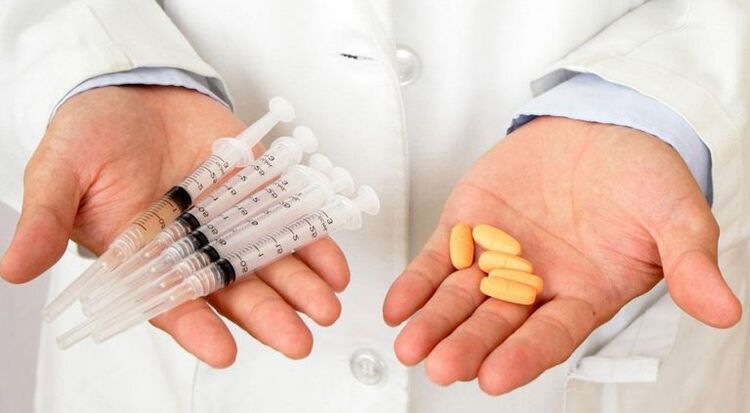
First, it is necessary to seek help with a rheumatologist for diagnosis and treatment, while treatment for more severe joints is related to orthopedics.
Treatment depends on the degree of the disease and the nature of its manifestation.Doctors choose treatment options for each patient separately.The basic principles of treatment include:
- Drug treatment.
- diet.
- physiotherapy.
- massage.
- gymnastics.
- kinseoteiping (recording hip joints with special patches).
- They resort to the help of canes and crutches to remove load from affected joints.
Drug Therapy
Treatment options for ineffective hip lesions include medication.The earlier you start treatment, the greater the chances of limiting conservative approach treatment without surgical intervention.
The graph of drug treatment includes a series of drugs:
- To relieve pain and reduce the inflammatory process, non-replacement anti-inflammatory drugs are used.
- When fluid accumulates in the joint cavity, use - Intra-articular injection.
- To feed tissues and improve blood circulation, cartilage protectants are used.
- Local treatment ointment is suitable for areas of affected joints.
Physical Therapy Procedures
Physical therapy approaches are designed to improve blood supply to affected joints and improve metabolic processes.The physics of hip joints include:
- Magnetic therapy.It helps to reduce pain and improve mobility of affected joints.
- Laser therapy.The function of the photolaser is to eliminate the inflammatory process, reduce edema and the recovery of cartilage.
- Thermal therapy.Due to the thermal effects on the affected areas, improvements in blood circulation and metabolic processes are normalized, including mixing, paraffin therapy.
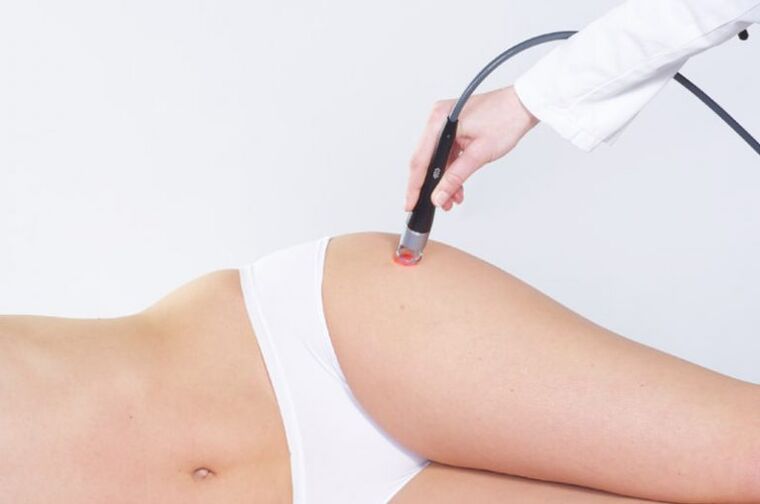
Each type of physical therapy procedure has a positive impact on the affected joints, but there are many contraindications at the same time.Physical therapy is not allowed during pregnancy, oncology, tuberculosis.
Massage and therapy for gymnastics
This set of treatment measures is an integral part of the complex treatment volume.
Benefits of massage and treatment of gymnastics:
- Improve blood circulation.
- Removes muscle cramps.
- Increased motor activities of the affected joints.
- Relieve pain.
- Diastolic effects in the joints of the affected joints are increased.
Massage classes are allowed at all stages of the disease, but at each stage, certain conditions are maintained.Therapeutic massage is performed only by specialized training experts, and each massage session is conducted at several stages:
- Back massage.It is done with the help of the caressing movement with the palm, helping to increase blood circulation and preparing for the next stage.
- Manual massage of the lower back.It is made by the same caress, rubs and kneading of the waist area.
- Massage in the sacra and berries area.
- Thigh massage.At this stage, experts perform compression and friction massage exercises to capture areas of the affected joints.
During stages 1 and 2 of the disease, it is recommended to conduct self-massive courses for at least 5 minutes a day.
During self-quality conversations, the order of actions is also important, and it is necessary to alternately perform the following exercises:
- Massage the posterior area with your palms to rise and fall along the spine, and rub backwards with your fists.
- In a standing position, start massage your hips from your hips to your ac bone and waist area.Complete the stroke to start the friction.
- The final stage is a massage of the hip muscles, which is performed in a sitting position.Perform alternative strokes, rubs and kneading.
Stages 3 and 4 of the disease indicate post-operative massage, treatment for rapid recovery.
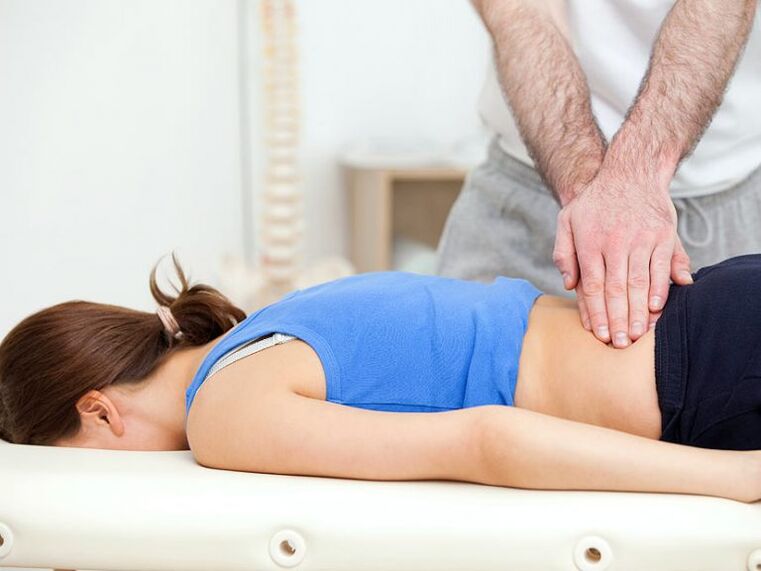
Massage classes are best alternate with therapeutic gymnastics.Gymnastics for arthritis are designed to increase blood flow to the hip muscles, which helps to better saturate joints with nutrients.
Each author's technique has its own characteristics and many contraindications to determine which gymnastic exercise program complies with the meeting doctor will follow.
At home, you can perform many simple exercises, such as:
- In the position lying on the back, lift each leg slowly, alternately at an angle of 50 degrees.
- Lying behind, bent your legs, lift your head from the floor and try to reach your knees.
- In the standing position, remove it, lift her straight legs backwards, trying to keep it in this position for a few seconds.
When engaging in gymnastics, it is important not to rush as many tasks as possible while keeping calm, calm breathing.Rapid, inaccurate movement can cause harm.It is important to remember that only the attending physician can prescribe exercises based on the condition of a particular patient.In addition, practice should be performed with the presence of an expert to control the correctness of the exercise.
Dietary Therapy
Diet plays an important role in treatment.In the treatment of arthritis, it is recommended to use 1600-1800 kcal per day and distribute the daily volume of 5-6 meals per day.Food should be balanced and rich in vitamins and trace elements.With overweight, choosing a good diet will help lose weight, thereby reducing the load on joint soreness.
Observe a proper diet, you need to consider what products must be included in the daily menu and what should be excluded from the diet altogether.
| Respected: | Necessary restrictions: |
| aspic | Espresso |
| Vegetables, fruits | Alcohol drinks |
| Low-fat meat and fish | Bakery Products |
| Milk and dairy products | Salt |
| Green | |
| Beans | |
| Buckwheat | |
| nut |
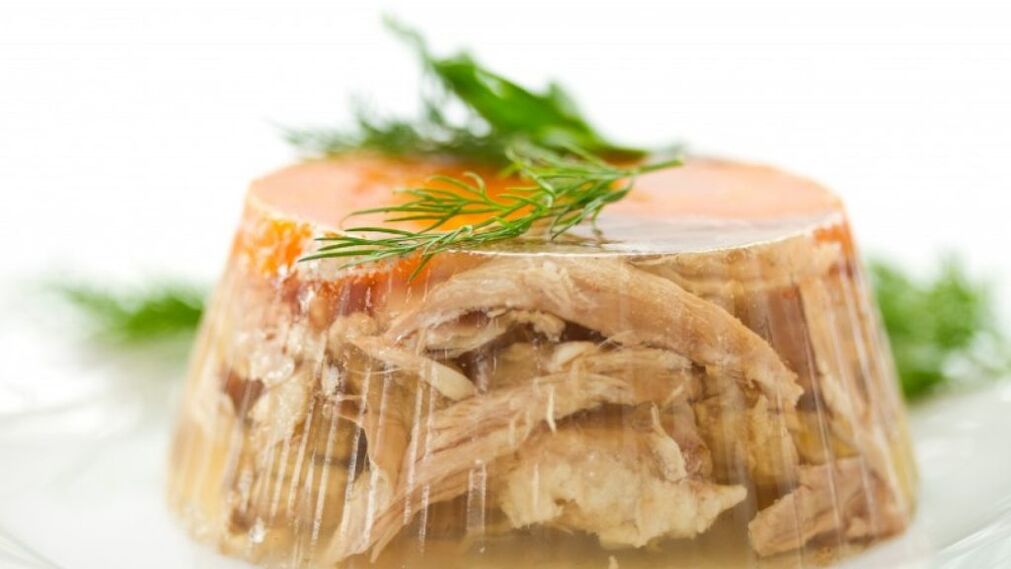
It is necessary to include enough vegetables and fruits in the food to increase the consumption of dairy products, and it is worth paying special attention to the products, rich animal protein (beef, Türkiye, chicken, low-fat fish varieties).It is recommended to include it in the menu jelly, rich in collagen, which strengthens and restores the cartilage tissue of the joints.
Surgery
Treatment of hip arthritis in early stages is limited by conservative approaches.It is usually a fairly correct drug treatment regimen and has appointed auxiliary methods to improve patient condition and slow disease progression.In many cases, the treatment of 3 and 4 degree joints means surgical intervention is required, which is in the replacement of the joint.
When do you need to operate?
Stages 1 and 2 of hip arthritis are surgical intervention at 3 and 4, and sooner or later surgery is required.When the joint changes reach the extreme stage, the surgery is proposed to the patient, while the complete destruction of articular cartilage and the large-scale growth of bone tissue.
After surgery, massage and exercise therapy are prescribed to quickly resume exercise activities during rehabilitation.
Traditional Medicine
What is joint arthropathy in hip joints and how it is treated in detail by a rheumatologist.After consulting the attending physician and appointing a treatment plan, it is recommended to consider folk medicines as an adjunctive treatment.Treating arthritis with folk recipes is a great extra method that helps reduce pain, relieve edema, and increase joint activity.
When treating folk therapy, two methods are used:
- Used to enter the room (rot, tin agent for healing herbs).
- For local use (oint, compression, packaging).
To eliminate the main symptoms of the disease, a saber-based tin agent was used:
- The swamp saber must be mixed with medical alcohol at a ratio of 1:10 and removed in a dark place for weeks.
- Then bring to a boil, filter and use to receive 1 tablespoon.l.3 times a day.
- At night, you can rub tin directly onto the affected joint areas to relieve inflammation and relieve pain.
Compression based on cabbage leaves has proven itself in treatment: several cabbage leaves and a calf leaf should be mixed together and kneaded by hand until the juice is formed and attached to the lesion for 30 minutes.This method helps to reduce inflammation and pain.
In the treatment of folk remedies, the herbs are actively used, including: St. John's wort, mint, chamomile, and broccoli.To obtain a healing ointment, it is necessary to mix the grass with petroleum jelly or baby cream and then rub the ointment into the joint immediately after cooking.

All other treatments should be considered only as ancillary methods that cannot independently cure the disease and are used in combination with drug treatment to enhance the effect of the therapeutic procedure complex.
prevention
To prevent disease, it is recommended to carefully monitor your health, pay attention to strengthening immunity, live a healthy lifestyle, and carefully monitor the quality of nutrition.
An important way to prevent arthritis is to prevent hypothermia and limit physical fatigue.It is recommended to observe diets designed to lose weight and prevent musculoskeletal system load.
In order to increase immunity generally, sclerosis and balanced physical fatigue are given priority.
Pregnancy and childbirth
Laminated articulation of the hip joint is the congenital pathology of the hip joint, which occurs due to the improper formation of joint tissue during intrauterine development.In most cases, this pathology can be successfully cured over time as the disease is detected promptly, but leaves the risk of arthritis in the hip joint as an adult.
During pregnancy, in the presence of hip arthritis, the overall load of the affected joints increases due to the body's total weight gain, which significantly exacerbates the progression of the disease.In addition to increasing weight gain, pregnant women's consumption will also deteriorate and their metabolism will slow down, which is also attributed to the increase in the cost of the body's own resources to provide everything the fetus needs.
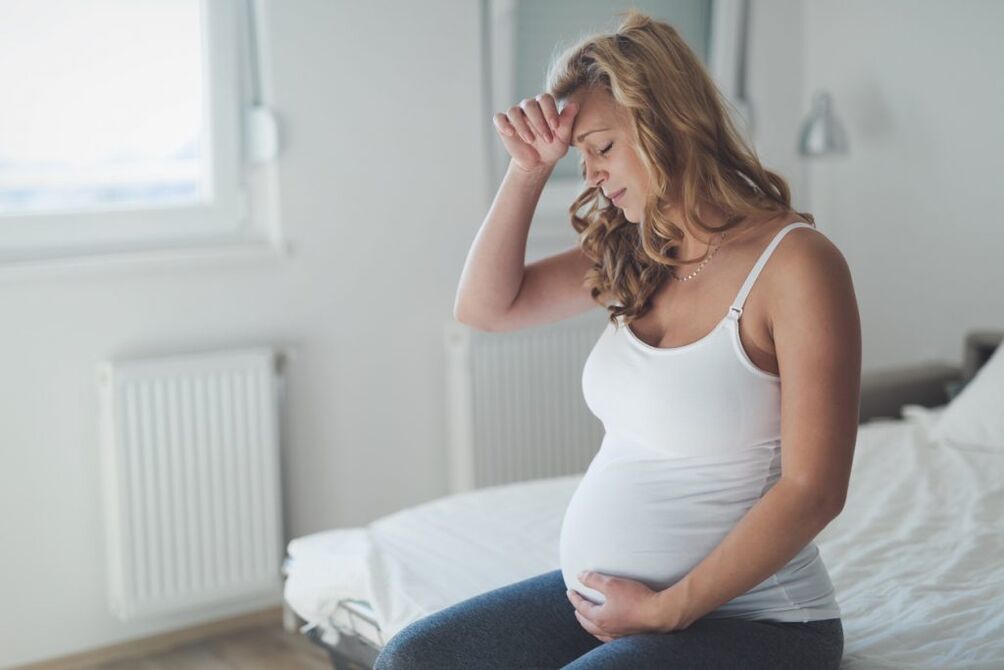
It is strongly recommended that pregnant women observe certain diseases throughout their pregnancy in the presence of diseases such as hip arthritis, i.e.:
- Limit exercise activity, especially during the third month of pregnancy, when the load on the acid joint is maximum.
- It is necessary for doctors to observe continuously.
- It is recommended to follow the doctor's advice.
- Swimming categories advantageously affect the distribution of load in vivo, increase muscle mass in affected joint areas, and remove voltage.
forecast
The prognosis is favorable by timely diagnosis of joint arthropathy in the hip joint.If the disease is detected in the first stage, treatment is provided in a conservative manner, the disease progression will slow down and usually not reach 2 degrees at diagnosis, which is usually completely curable.
During stages 3 and 4 of the disease, timely surgery is performed, predictions are still beneficial and meet all prescriptions recommended by the doctor and are constantly controlled for attending the doctor.With good operating measures, artificial joints have been served for decades.
complication
The main and most adverse complications are possible disability.Disability occurs due to complete loss of motor activities in the injured joint.Due to symmetrical lesions in both joints, one loses the ability to move independently, which significantly limits lifestyle and also creates the risk of other complications (stagnant pneumonia, stress soreness).
To prevent this serious consequence, it is recommended to start treatment when the first sign is identified to prevent the disease from progressing.



















